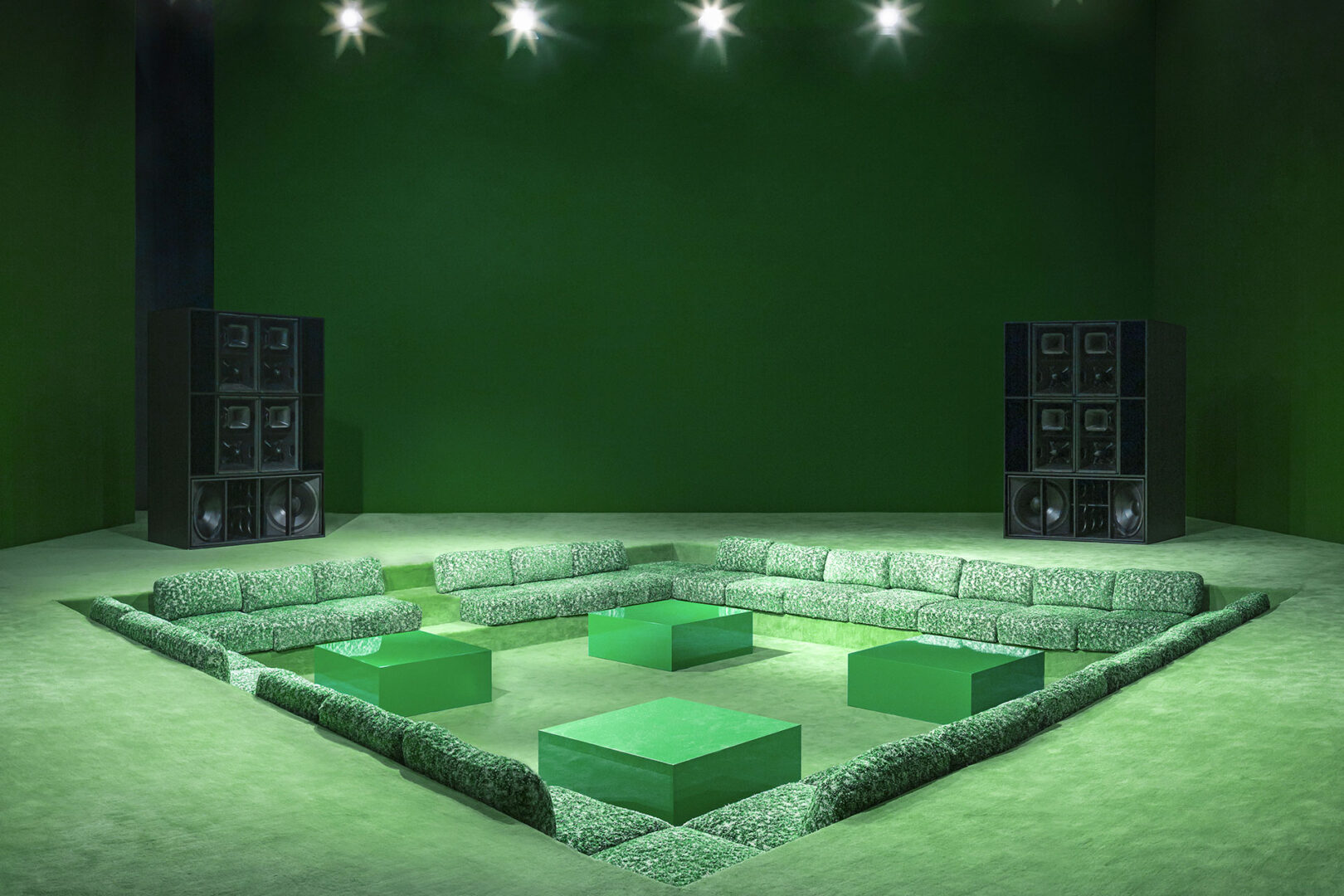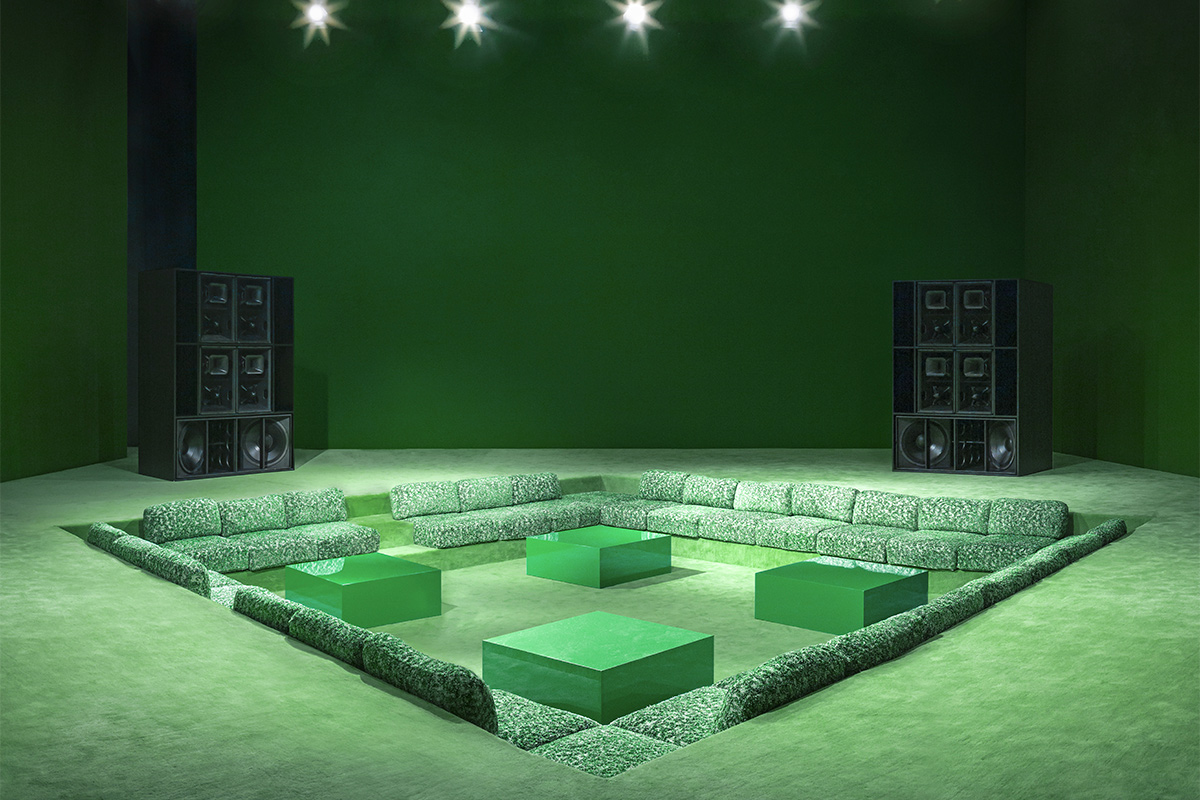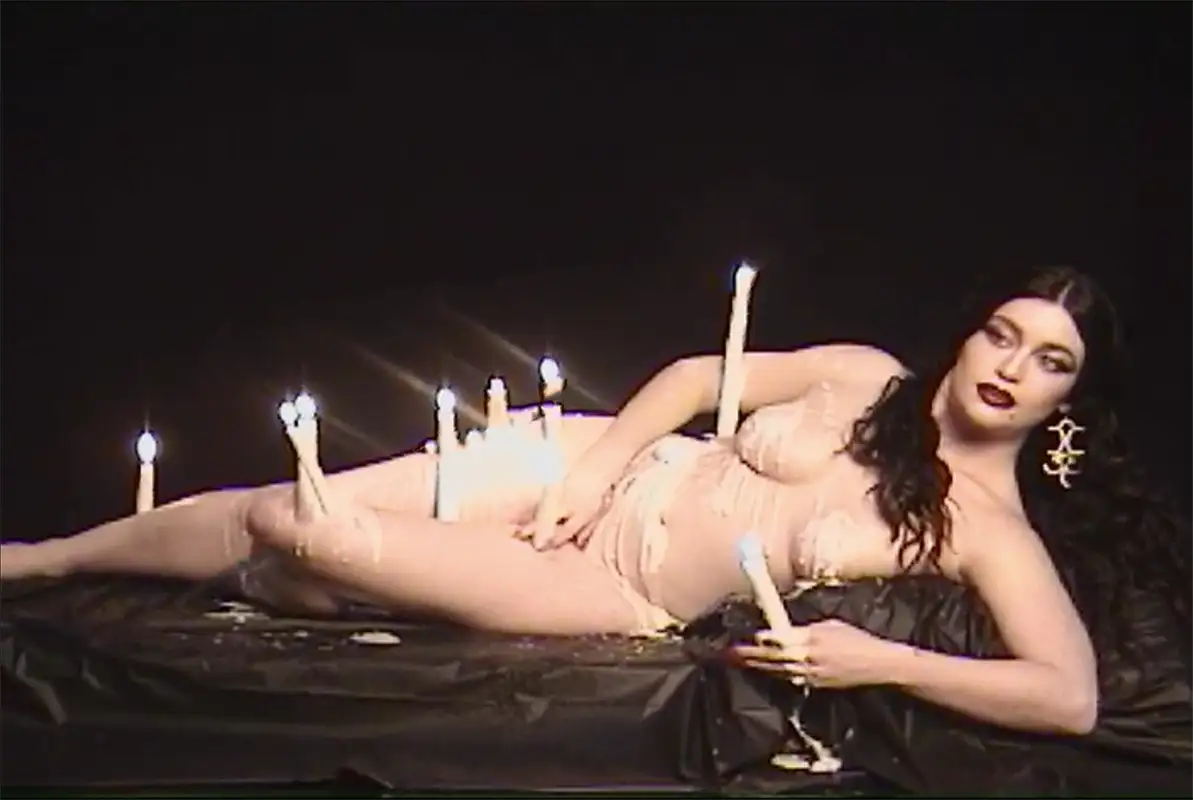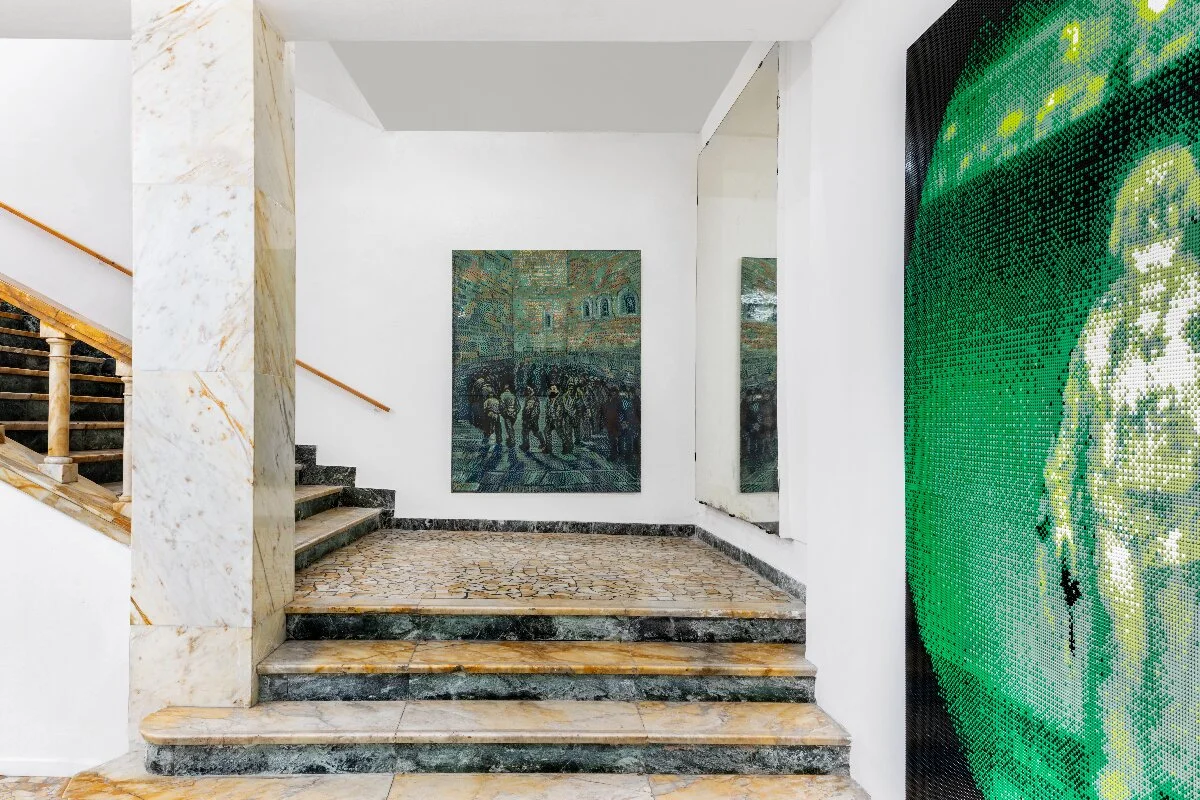«I had to create a space where people would be able to express themselves». Bottega Veneta and Carl Gerges set up the first fashion hub dedicated to dialogue and interaction
The Square. Bottega Veneta’s new community oasis
In an opposite dimension from the catwalk haze and the indulgence aura of events, for Bottega Veneta, fashion becomes a conversation. Reaching out to the Lebanese architect Carl Gerges, the Italian brand launched ‘The Square’. A nomad cultural hub opened to discussions between artists and intellectuals inaugurated in Dubai. No trace of products or advertisements, the visual component was silent.
The project aims to create a safe space for dialogue, with guests mirroring their culture and voicing their origins. For the first placement of ‘The Square,’ the list of invitees included: the Syrian chef Soleman Haddad, Yemeni narrator Shaima Al Tamimi, Sudanese-British poet Asma Al-Badawi and the Canadian poet, and songwriter Mustafa, who was an active part of Bottega Veneta’s community, also participating in the Fall-Winter 2022/23 show.
«We wanted to invite artists and people who would bring life to this cube that we’ve created», says Carl Gerges, ‘The Square’ architect and concept creator. Happening during Ramadan month, the event focused on bringing back its essence through meaningful conversations and cultural intersection. «There was no music, no instruments, just words and the human voice. This space was designed to enhance those stories».
Inspired by the Maijils’ constructions, the project embodies a temple of reflection and discussion. Talking, storytelling, confiding in one another.
‘The Square’ became an archaic modernization of the space where nothing has more novelty than tradition. It takes innovation to be able to go back to the roots. «For this particular event, we felt that language and words are crucial nowadays because they’ve disappeared with social media, images, and elect visuals. We perceive so many things visually that words get lost. When speaking of bridging cultures, it doesn’t just mean to put a bunch of artists from different regions in the same room and expose their work. I care about the artists, about them talking to each other, having conversations».
Every night, the artists initiated and led the dialogue, using their way of expression, from poetry to written songs. Carl Gerges was one of the event’s pillars, opening the talks about space; everything became intimate in ‘The Square’ that hosted testimonials on identity, mental health, faith, and personal lives.
«I had to create a space where people would be able to express themselves. The challenge here was engaging the audience without having an amphitheater effect, without a person standing on stage. I rather wanted to have the speaker be part of the audience, so there was an occurring discussion, and people stayed on until 2 am every night. But, unfortunately, that interaction got lost during fashion shows».
With a commitment to evolve and redeem other cultures, The Square is moving to Tokyo. Whereas still mysterious, its upcoming appearances will enact other countries in Asia and possibly Sao Paulo or Saudi Arabia. Every new city will engage new conversations, new artists, and heritage.
Carl Gerges on relocating the fashion dialogue
Like an exclusive festival, ‘The Square spontaneously raves with the concept of community fostering. The idea and architecture were inspired by Majlis, an Islamic space dedicated to gatherings and debates, the word itself meaning ‘to sit’. Majlis can have different connotations, from council to saloon or private space. It intertwines with all the areas of one’s life, from politics and administration to religion and art. Carl Gerges explains how «in all of the houses, instead of seeing a living space, you would see a Majlis space, which like the conversation pits, originates from the 60s», its architecture meant to stimulate interaction.
The event took place for three nights in a row, experimenting with the reaction of a mixed audience. Due to the small capacity, the guest list was invite-only, with twenty-five people on the first evening. Following the discussion rhythm and the intensity of experience testifying, The Square opened its gate for 100 people on its last night.
«It naturally came together. The whole event was very consistent in a way, but at the same time, it had different qualities of moments. People even started walking around and exchanging places, having side conversations», Mr. Gerges recalls. Through the inception of a new discussion shelter, Bottega Veneta supported the artist collective in Dubai. «We didn’t try to revolutionize the human community there; we gave them a space to occupy and express themselves, but you can’t control how people interact in the space».
One of the goals was to offer an alternative to punctual fashion shows, one-time events in which brands invest high budgets in temporary structures. Carl Gerges plans to reuse the elements he and his team designed for ‘The Square’: «we made the console conscious choice of using forget fabrics to do the cushions and the seats. The idea is to send these seats to Milan or Tokyo».
On music and architecture. A conversation with Carl Gerges
Songwriter, composer, artistic director, stage designer, musician, and architect, Carl Gerges is undoubtedly immersed in the creation process. In 2008, along with his university colleagues, he formed the indie rock band called Mashrou’ Leila (‘An Overnight Project’), the name inspired by the group’s all-night jam sessions.
«When we used to tour, we wouldn’t be like those sex drugs and rock and roll bands. We used to be nerds», Gerges remembers, explaining how his relation to art and architecture was always part of his interests. «we used to go a lot to museums; every time we would discover a new city, we would go and walk for hours and look at the buildings». Music made Carl Gerges get in touch with fashion through many collaborations counting an opening performance for the YSL museum in Marrakesh. To this day, music represents one of the principal sources of inspiration.
«When I approach a project, I approach it like, I used to approach songwriting. I love to work with constraints, proportions, and sequences. Those are the actor key terms that are common for architecture and music». One example is the Villa Shams in Lebanon, a construction intertwined with music, following a sequence, having a circuit and flow: «It is on a grid-like most pop songs are, four out of four beats, it follows a grid and a bit», Gerges explains. He still relays on music in the development process, replacing mood boards with playlists.
As an architect, Gerges seeks to build a relationship between the location and its context, remaining loyal to its culture and visual identity. I never design a space that fits anywhere; it goes against my principles. For me, every area depends on the culture and the history of where it’s happening. Imagining a habitat is like an anecdote of the inhabiter. For the young architect and musician, one intriguing facet of design is decoding and discovering new artisans, materials, and habits since the final purpose is catering to people and users of the space.
Between architecture and fashion. How the collaboration began
«I think all human beings are born creative, and they express their creativity differently». Carl Gerges is only one example of how disciplines intertwine, and the thirst for creation remains valid in all fields. He started working with Bottega Veneta long before The Square when he developed the fashion show scenographies, being involved in different projects as a consultant.
«It happened naturally with Bottega Veneta and me because we share many values like our love for Italian architecture and Italian designs from the 50s and 60s, our love for exploring materials and artisanal techniques». Carl Gerges met the head of worldwide events and collaborations, Alexandre-Camille Removille, and became friends, a link that made everything fall in sync.
Now at the helm of the Italian fashion brand, the creative director Matthieu Blazy stepped into the position after the departure of Daniel Lee. A young dynasty of green, the essence of Bottega remains untouched and more alive than ever. Carl Gerges ducked its world, and when designing The Square, he only used Bottega Veneta fabrics in the characteristic thick green shade. At the same time, the conversation pits were another element chosen to embody the Italian brand aesthetic.
«It was in the details like the touch of the fabric, the carpet, even the lighting. I didn’t want to have lighting that you can see but rather that you can feel. We’ve worked on those custom-made speakers that we used to find in our grandparents’ apartments». While obtaining an authentic space, Gerges mirrored the Italian house’s mixture of modern and vintage traits alongside its artisanal techniques, fever intersecting with material innovation.
Between fashion and architecture, there’s always the human being who can visualize and sense his life through both arts. «They’re expressions of people trying to convey an idea. You have your skin, the building is the third skin, and fashion is your second skin. I think they all impact society, influencing how you look and how you live.»
Carl Gerges
Lebanese musician and architect. Gerges has been featured on the cover of L’Officiel Levant and the cover of Architectural Digest Middle East as an architect; and on the Middle East edition of Rolling Stone magazine and GQ Middle East as a musician. He started playing the drums and the piano at an early age. Gerges co-founded Mashrou’ Leila in 2008 while studying architecture at the American University of Beirut. He officially launched his architecture studio Carl Gerges Architects, in March of 2020.




















